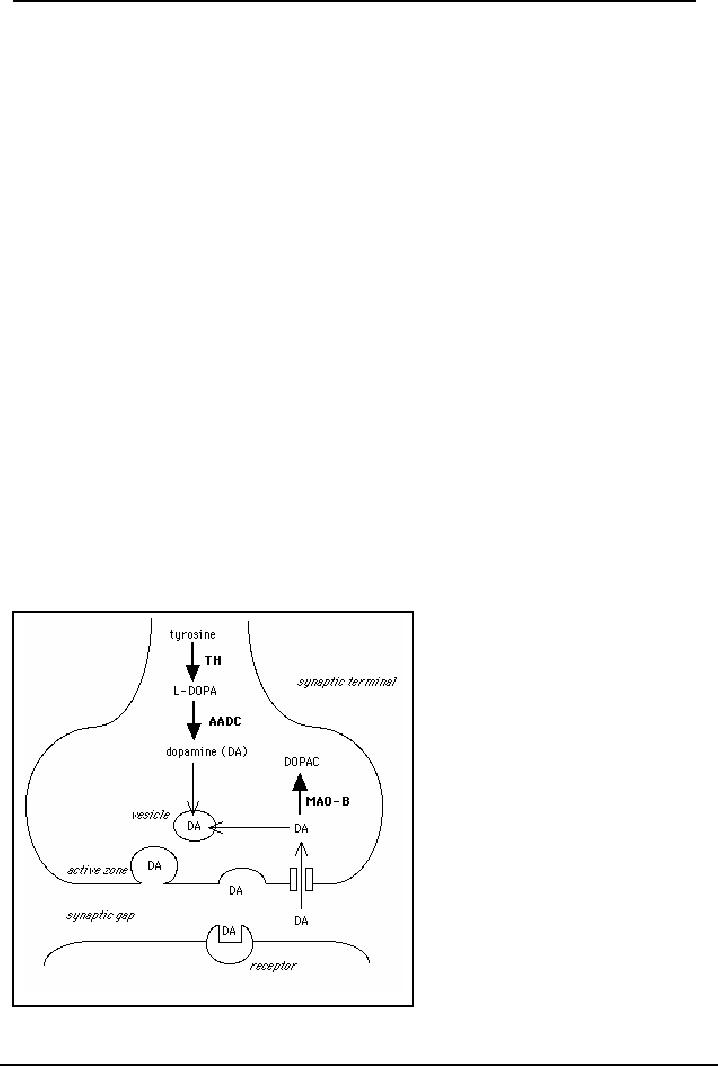 |

Neurological
Basis of Behavior (PSY -
610)
VU
Lesson33
Basic
Neurochemistry
Objectives:
To
familiarize the students with
the
Various
NT and their role in the modulation of
behaviors
Classification
of Neurotransmitters. Monoamines:
Catechoalimnes
and
Indolemaine,
acetylcholine,
amino acid, and Peptide
Neurotransmitters
role in modulation of behaviors and
Aberration
Drugs
and Behavior:
Classification
of Psychopharmacological substances
Behavioral
correlates, Treatment:
Mechanism
of synaptic transmission
Major
neurotransmitter: Catecholamines
We
have already discussed one of the
catecholamines, Dopamine which is first
in this chain of
synthesis.
Dopamine is the preceding
step in the synthesis of Norepinephrine
NE, (also known as
Noradrenaline
NA, which is the abbreviation used in
this section)
Norepinephrine/
Noradrenaline
One
of the major neurotransmitters of the brain
this NT fall under the general
category of monoamines,
further
categorized as catecholamine because of its chemical
composition. In this system
synapses are
known
as noradrenergic synapses, NA is found in
various parts of the brain
as well as the autonomic NS
(in
the hypothalamus and the mid brain) in
the Peripheral nervous system ( very
important role in the
sympathetic
functions and hormonal
releases : readiness for
fight or flight) and at the adrenal
glands.
This
is involved in a large number of
behaviors with a wider
influence as compared to DA.
The
involvement
in mood, emotional states,
motivation (hunger, thirst,
fight/ flight etc) dream,
rewards
(learning),
sleep alertness and wakefulness is well
documented.
NA
originates from a small
group of neurons located in the back
part of the brain and project by
sending
fibers
and axons to widespread region of the
brain. This is why it is
involved in so many
behaviors.
The
Noradrenergic synapses lead to
Inhibitory Post Synaptic
Potentials in the Central Nervous
System
and
Excitatory Post Synaptic
Potentials in the Autonomic Nervous
System (which includes
the
sympathetic
nervous system), and the target
organs ( such as the heart).
The
Noradrenergic neurons do not
release NT from terminal
buttons (as other NT's
do) instead of it
they
release NA through the axonal
varicosities, which are
beadlike swelling of axonal
branches. The
varicosities
give the axonal branches of NA
neurons the appearance of beaded
chains or like a necklace
of
beads). NA is synthesized or manufactured in the adrenal
medulla and the brain from
DA. Remember
that
the brain manufactures all
NT's, and therefore NA also
independently. Even though
large amounts
of
NA is manufactured and used in the body,
it can not cross the
blood-brain barrier to enter the
brain.
NA
synthesis
1.
Synthesis: This is a
simple one step process for
transforming Dopamine into NA.
Dopamine is
hydroxylated
by Dopamine
B-hydroxylase. This
enzyme was discovered in 1960 in the
adrenal medulla,
and
this is the same enzyme
which acts on DA in the
brain. The synthesis from DA
to NE takes place
within
the vesicles (unlike other
NT's where this is carried
out in the cell
body).
122

Neurological
Basis of Behavior (PSY -
610)
VU
2.
Dopamine is hydroxylated by Dopamine
B-hydroxylase,
to
form Noradrenaline. This
hydroxylation
process
can be blocked by Disulfiram.
The blockade leads to a
buildup of DA (since the tyrosine
is
being
converted to Dopamine) at the same
time this reduces NE levels
in the neurons, and therefore in
the
brain.
3.
Deactivating Norepinephrine by MAO and
COMT leads to
following:
The
metabolite after the breakdown of NE
occurs in two ways
a)
It
forms the Vanylmandellic Acid (VMA), a
metabolited which is found
mostly in the body,
very
little
in the brain (as it is excreted
quickly).
b)
The
MHPG, a glycol derivativethe
(abbreviation of 3 methoxy-4
hydroxy phenylglycol).
This
metabolite
is found that in stress there
are increases in amounts of
MHPG in the locus coerelleus.
Noadrenergic
Pathways
There
are two major pathways of NA the
Dorsal bundle and the Ventral
bundle with several pathways
projecting
in each one of these. The pathways
are known as a 1, 2,4,5,6, and 7. All
these originate in the
lower
brain areas and ascend to
the cortex i.e. they
originate in the Pons and the
medulla and ascend to
the
cortical areas, the limbic
systems and the
hypothalamus.
The
A 6 comprises of the dorsal bundle which
originates in one area, the locus coerelleus
located on the
ventral
areas of the ventricles, and sends
out diffuse innervations to
cerebellum-cerebral cortex
and
hippocampus
through the Medial Forebrain
Bundle (MFB). This therefore
is involved in sleep,
awakening,
moods, neuro endocrinal
functions and temperature
regulation.
The
A 1, 2, 4, 5, and 7 are the various
points or locations from where the
ventral bundle originates in
the
pons,
medulla and innervates the brain stem and
the hypothalamus
The
ascending fibres of A 5 and A 7 project
to the cortex, hypothalamus and are
part of the limbic
system
(hippocampus and septum
whereas
the descending fibers go down
into
the spinal cord
Receptors.
There are types of NA
receptors
identified by their
sensitivities
to
various drugs: the Alpha receptors
and
the
Beta receptors
a)
Alpha1
and Beta 1 are found mainly in
the
post receptor membranes
b)
Alpha
2 is primarily presynaptic
autoreceptors
(these emerge out of the
presynaptic
membrane area to monitor
and
control the levels of the membrane
by
a self inhibiting action). It is like the
one
hand of the same person holding the
other
hand (for support and for control)
c)
Beta
2 receptors are found in the CNS
but
are associated with glia cells,
muscles,
and walls of blood vessels.
123

Neurological
Basis of Behavior (PSY -
610)
VU
Receptor
A1-
these receptors are located
post synaptically on blood
vessels and in the spleen and
peripheral
tissues:
Prazosin, Indoramin selective antagonists
which work near the heart. So
these receptors carry
the
commands of the brain directly to the
organs
A2
these
receptors are located on presynaptic
nerve terminals in the periphery
(not in the brain):
Yohimbine
is a selective antagonist (stops/blocks action of NA) and
clonidine is selective agonist.
These
receptors are also located
in the pancreas.
B1:
these
receptors are linked to stimulation of adenylate cyclase. These are found in
greater numbers in
the
heart and cerebral cortex. Epinephrine and NE potent agonists. The presence of
these receptors vary
a
lot in the brain region
B2:
These
receptors are linked to the
stimulation of adenylate cyclase.
This is found in high
concentration
in the lungs and the cerebellum. For
these receptors E is more potent
than NE. The
drug
salbutamol
is a selective agonist
Steps
in NA synthesis where drugs can
modulate action:
As
discussed earlier we saw
that there were drugs which interacted
specifically with the DA
synthesis,
in
the same way we will see
how drugs interact and modify the
working of the NA synthesis
process.
Step
1. Enzyme Synthesis
a)
The first step where this
neurotransmitter can be modified is at
the level of sysnthesis of
Tyrosine.
The
hydroxylation of Tyrosine by Tyrosine
hydroxylase can be effectively
blocked by Alpha
Methyl
Para
Tyrosine AMPT: This is the same
process as in Dopaminergic synthesis.
Since Tyrosine is the
precursor
for both DA and NA therefore
this is the rate limiting
step for NA as well.
Reducing available
Tyrosine
by AMPT would reduce both DA and
NA
b)
The
second step in the enzymatic synthesis is
where Dopamine B- hydorxylase action on
dopamine is
blocked
by a substance known as Disulfiram, and
another drug labeled as FLA-63.
Both allow a buildup
of
Dopamine but conversion to NA cannot
take place as this is blocked by the
drugs
Step
2 Storage vesicles: The
two drugs which interfere
with the storage vesicles
are Reserpine, and
Tetrabenazine.
Reserpines effects on the storage
vesicles are long lasting-
thereby the effect on NA is
also
longlasting. Further, the storage
vesicles are irreversibly
damaged, and forming new one
take time.
Tetrabenazien
also interferes with the
storage vesicles, but this is
neither long lasting nor
irreversible
effect.
Step
3. Release: The release of NA
is affected by Amphetamine which increases the release of NA
molecules
from the presynaptic area, and also blocks reuptake for enhanced and long
lasting effects.
Step
4. Post receptor site interaction: This involves interaction
at the post receptor sites. This could be
agonistic-
meaning that they stimulate these sites, or antagonistic when they block these
sites. The drug
Clonidine
is very potent receptor stimulant (agonist), and Phentolamine is an A- blocking
agent, and
Sotalol
a B-blocking agent
Step
5: Reuptake: The action of NA
molecules can be stopped by their reuptake into the
presynaptic
area
(and back into the vesicles). The drug Desipramine belonging to the tricyclic
antidepressant group,
acts
through blocking reuptake of the NA molecules (thereby enhancing NA levels in
the synaptic cleft)
Step
6. The
NA or DA molecules floating in the presynaptic area are degraded or broken down
into
inactivated
forms by MAO. This degradation by MAO blocked by the MAO inhibitors (which
inhibit
124

Neurological
Basis of Behavior (PSY -
610)
VU
the
action of inhibitor) leads to an increase in its levels. The antidepressant drug
Pargylin is a potent
MAO
inhibitor it acts to block MAO action.
Step
7: Norepinephrine
can be inactivated by the enzyme COMT in the synaptic cleft. The
drug
Tropolamine
blocks COMT action.
(From
Cooper Bloom and Roth pages
180-182).
Thus
we have seen the steps in the synthesis
of NA which can be modified by
drug action. These
drugs
are
mainly psychotropic drugs (act on the
psychological states).N
NE
and Behaviors:
We
will now proceed to discuss
the behaviors which are
affected, modified changed or
controlled by
Norepinephrine
/Noradrenaline
Arousal:
The
behavioral arousal and arousal of electrical
activity in the brain is correlated
with Increases in NE
by
MAOI. Thus Momonamine oxidase inhibition
leads to an increase in available NA
which leads to
increases
in arousal as seen in behavioral
excitation and EEG activity.
Furthermore, in states of
stress
NA
levels are also increased.
In states of stress where a person cannot
go to sleep (stays awake for
long
periods
because of stress), the NA levels
are also increased in the
brain. It is clearly only
NA
involvement
(No DA involvement- complete depletion of
striatal DA still leads to
waking and
sleeplessness)
If
NA is injected intraventrically (directly
into the brain) also leads
to behavioral excitation. This
means
that
increases in NA leads to a state of
arousal, excitation, and increased
activity.
NA:
Conditioned Avoidance
There
is evidence that NA is involved in
conditioned avoidance in the learning and
conditioning
paradigms.
If we inject Reserpine (which ruptures
the vesicles to spill out the NA
molecules) and also
Alpha
Mehtyl paratyrosine to block
any further synthesis of
tyrosine (and DA and NA) we
find
complete
abolishment of a learned conditioned avoidance of
electric shock. (The animal had
earlier
learned
to avoid shock, but with no NA the
response is gone). Thus this
shows that NA plays
an
important
role in avoidance behavior.
How? Through either the
reward and punishment
mechanisms or
through
the learning and memory centers
being affected.
How
do we make sure that it is only decreases in NA which leads to this response? If
we give
Disulfiram
or FLA-63 which will increase DA but decrease NE by blocking the synthesis of
NE. we
also
abolish the learnt avoidance response.
Thus
we have seen that NA is an important NT
and is involved in a wide range of
behaviors.
References:
1.
Kalat J.W (1998) Biological
Psychology Brooks/ Cole
Publishing
2.
Carlson N.R. (2005) Foundations of
Physiological Psychology Allyn and Bacon,
Boston
3.
Pinel, John P.J. (2003)
Biopsychology (5th edition) Allyn and Bacon
Singapore
4
Bloom F, Nelson and Lazerson (2001),
Behavioral Neuroscience: Brain, Mind and
Behaviors (3rd
edition)
Worth Publishers New
York
5.
Bridgeman, B (1988) The
Biology of Behaviour and Mind. John
Wiley and Sons New
York
6.
Brown,T.S. and Wallace.(1980) P.M
Physiological Psychology
Academic
Press New York
7.
Seigel, G.J. (Ed. in chief)
Agranoff, B.W, Albers W.R.
and Molinoff, P.B. (Eds) (1989)
Basic
Neurochemistry:
Molecular, Cellular and Medical
Aspects
125

Neurological
Basis of Behavior (PSY -
610)
VU
8.
Cooper,J.R, F.E Bloom,and
R.H Roth (1996) Biochemical
basis of neuropharmacology 7th
Edition,
OUP
9.
Pharmacology, Biochemistry and
behavior
(Additional
references for the module: Iversen and Iversen, Gazzaniga, Bloom, and
handouts)
Note:
References, 3, 8, 9 are more closely
followed in addition to the references
cited in text.
126
Table of Contents:
- INTRODUCTION:Descriptive, Experimental and/ or Natural Studies
- BRIEF HISTORICAL REVIEW:Roots of Behavioural Neurosciences
- SUB-SPECIALIZATIONS WITHIN THE BEHAVIORAL NEUROSCIENCES
- RESEARCH IN BEHAVIOURAL NEUROSCIENCES:Animal Subjects, Experimental Method
- EVOLUTIONARY AND GENETIC BASIS OF BEHAVIOUR:Species specific
- EVOLUTIONARY AND GENETIC BASIS OF BEHAVIOUR:Decent With Modification
- EVOLUTIONARY AND GENETIC BASIS OF BEHAVIOUR:Stereoscopic vision
- GENES AND EXPERIENCE:Fixed Pattern, Proteins, Genotype, Phenotypic
- GENES AND EXPERIENCE:Mendelian Genetics, DNA, Sex Influenced Traits
- GENES AND EXPERIENCE:Genetic Basis of behavior, In breeding
- GENES AND EXPERIENCE:Hybrid vigor, Chromosomal Abnormalities
- GENES AND EXPERIENCE:Behavioral Characteristics, Alcoholism
- RESEARCH METHODS AND TECHNIQUES OF ASSESSMENT OF BRAIN FUNCTION
- RESEARCH METHODS AND TECHNIQUES OF ASSESSMENT OF BRAIN FUNCTION:Activating brain
- RESEARCH METHODS AND TECHNIQUES OF ASSESSMENT OF BRAIN FUNCTION:Macro electrodes
- RESEARCH METHODS AND TECHNIQUES OF ASSESSMENT OF BRAIN FUNCTION:Water Mazes.
- DEVELOPMENT OF THE NERVOUS SYSTEM:Operation Head Start
- DEVELOPMENT OF THE NERVOUS SYSTEM:Teratology studies, Aristotle
- DEVELOPMENT OF THE NERVOUS SYSTEM:Stages of development, Neurulation
- DEVELOPMENT OF THE NERVOUS SYSTEM:Cell competition, Synaptic Rearrangement
- DEVELOPMENT OF THE NERVOUS SYSTEM:The issues still remain
- DEVELOPMENT OF THE NERVOUS SYSTEM:Post natal
- DEVELOPMENT OF THE NERVOUS SYSTEM:Oxygen level
- Basic Neuroanatomy:Brain and spinal cord, Glial cells, Oligodendrocytes
- Basic Neuroanatomy:Neuron Structure, Cell Soma, Cytoplasm, Nucleolus
- Basic Neuroanatomy:Control of molecules, Electrical charges, Proximal-distal
- Basic Neuroanatomy:Telencephalon, Mesencephalon. Myelencephalon
- Basic Neuroanatomy:Tegmentum, Substantia Nigra, MID BRAIN areas
- Basic Neuroanatomy:Diencephalon, Hypothalmus, Telencephalon, Frontal Lobe
- Basic Neurochemistry:Neurochemicals, Neuromodulator, Synaptic cleft
- Basic Neurochemistry:Changes in ionic gates, The direct method, Methods of Locating NT
- Basic Neurochemistry:Major Neurotransmitters, Mesolimbic, Metabolic degradation
- Basic Neurochemistry:Norepinephrine/ Noradrenaline, NA synthesis, Noadrenergic Pathways
- Basic Neurochemistry:NA and Feeding, NE and self stimulation: ICS
- Basic Neurochemistry:5HT and Behaviors, Serotonin and sleep, Other behaviours
- Basic Neurochemistry:ACH and Behaviors, Arousal, Drinking, Sham rage and attack
- Brain and Motivational States:Homeostasis, Temperature Regulation, Ectotherms
- Brain and Motivational States:Biological Rhythms, Circadian rhythms, Hunger/Feeding
- Brain and Motivational States:Gastric factors, Lipostatic theory, Neural Control of feeding
- Brain and Motivational States:Resting metabolic state, Individual differences
- Brain and Motivational States:Sleep and Dreams, Characteristics of sleep
- Higher Order Brain functions:Brain correlates, Language, Speech Comprehension
- Higher Order Brain functions:Aphasia and Dyslexia, Aphasias related to speech
- Higher Order Brain Functions:Principle of Mass Action, Long-term memory
- Higher Order Brain Functions:Brain correlates, Handedness, Frontal lobe